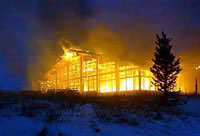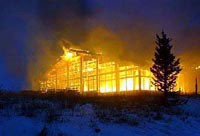A little over two years ago, fire swept through five buildings and four ski lifts in Vail, Colo., causing more than $12 million in damage, upending a small town already reeling from enormous change, and eventually introducing the word ecoterrorism into the mainstream lexicon.

Burning down the lodge.
Photo: earthliberationfront.com.
Indeed, so prominent were the arson fires of 19 Oct. 1998 that the event not only spawned numerous news stories but also elbowed its way to becoming a minor story line on the TV drama “The West Wing.” In one episode, after some staff bantering over the physical characteristics of the animal known as a lynx, the Vail fires are cited as a spectacular show of force by a little-known group (and one that ought now to be taken seriously, it is implied) called the Earth Liberation Front.
In actuality, the ELF has claimed responsibility for more than 20 major crimes, including fires that destroyed three homes on Long Island, N.Y., last month.
Two days after the Vail fires, the ELF released a communique that explained it had set the fires because a proposed expansion project at the ski resort would ruin lynx habitat. “Putting profits ahead of Colorado’s wildlife will not be tolerated,” the notice read. It then advised skiers to be safe and go elsewhere.

Powder Burn:
Arson, Money and Mystery
on Vail Mountain
By Daniel Glick
Public Affairs, 288 pages, 2001
The legitimacy of the ELF’s claim and the investigation of the fires — which are still unsolved — is the subject of Daniel Glick’s new book, Powder Burn.
A special correspondent for Newsweek, Glick wrote the book, he explains in the prologue, because after years of covering the Rocky Mountains West, he came to believe that the Vail story captured the quintessential aspects of what has been called “the new West.” This new West, a beacon for dot-commers and anyone else with enough wealth to buy a multimillion dollar house and then bulldoze it in order to build a more suitable home, has roused the frustration and resentment of those who prefer the West as it once was: simple, quiet, and unpopular. Thus, although the identity of the Vail arsonist remains a mystery, there is no surprise that such animosity was here. A conflict had been simmering for years, and as Glick writes, “The suspect list was a crowded place.”
As far as mysteries go, this story is unsatisfying. There is no neat and tidy ending. There is no infiltration of the ELF, although Glick tried. And readers seeking a primer on the lynx will be disappointed — this isn’t that sort of book.
Powder Burn does, however, provide a thorough presentation of the history and transformation of a lettuce patch and sheep pasture into a world-class ski resort. It’s a story about how two guys named Pete Seibert and Earl Eaton first cut trail, how the popularity of skiing took off, how undeveloped private land became an anomaly. It is fundamentally a story about class warfare — which just happens to be set in the nation’s biggest ski resort.
Glick introduces an abundance of people who are tied to Vail in one way or another, to whom the resort is work, fortune, sport, or home. They own the resort; groom the slopes; run the local coffeehouse; and enforce the law. And some of these people — particularly members of a group called the Ancient Forest Rescue — want to stop the resort expansion.
“As I hung out in the bars and in the slopes, in the humble double-wides, and in the sumptuous multimillion dollar condominiums, I couldn’t shake the sense than many people believed the current owners of the ski area somehow deserved to be burned,” Glick writes in his book’s epilogue. “In any company town, it’s not unusual for the locals to resent the company; but the depth of antipathy … was startling.”
As a profile of a place, Powder Burn succeeds because it immerses the reader in every facet of Vail life. Glick’s book doesn’t break new ground as an investigation of environmental activism, but it provides a context to understand the underlying causes of dramatic events like the Vail fires — and to understand why such acts are likely to recur in the West and elsewhere.


